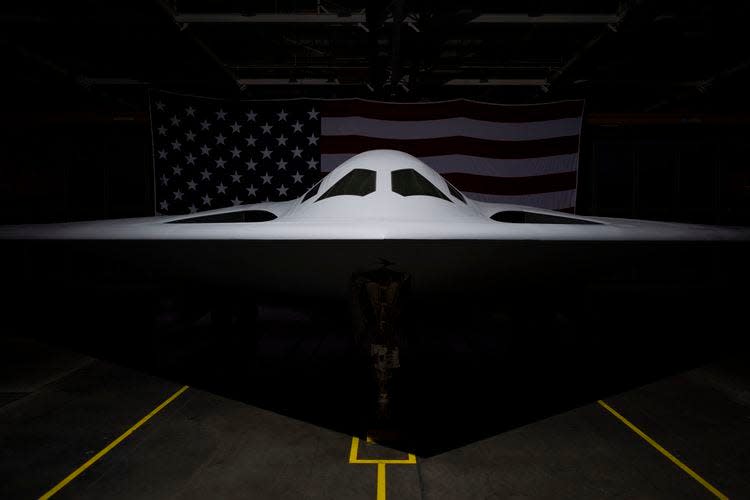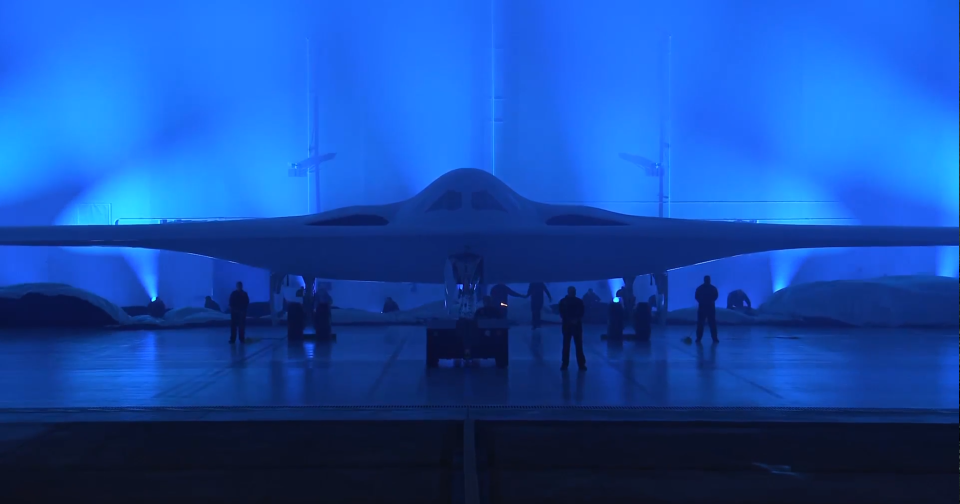B-21 bomber revealed Friday night, and Abilenians who were there share their impressions
- Oops!Something went wrong.Please try again later.
The B-21 Raider was revealed Friday night at Northrop Grumman's Palmdale, Calif., headquarters, marking the first time the sixth-generation aircraft, which in time will be stationed at Dyess Air Force Base, was seen by the public.
Two members of the Military Affairs Committee of the Abilene Chamber of Commerce were there to witness the plane's unveiling firsthand.
"You talk about chill bumps," said Gray Bridwell, vice president of the committee. "When they open that hangar, that's a big deal."

The aircraft itself, initially covered from onlookers' gaze, slowly was revealed and then gently rolled forward, its presence punctuated by a lightshow of shifting blue tones.
The unveiling, also accompanied by dramatic music, followed a flyover by aircraft from Air Force Global Strike Command.
Greg Blair, chairman of the MAC and also in California, was impressed with the rollout, calling it a "phenomenal feeling" to finally get to see the plane from a distance of about 75 feet - much closer than either expected.
What they could see was a plane that looks akin to the current B-2, but has a thinner wing profile.
"To say it was exciting would be the understatement of the year," Blair said. "... For a long time, we've been hearing it's going to look like a B-2, and there are obviously similarities.
"But it's different at the same time."
Exact specifications, such as dimensions, range and payload weren't shared, but that didn't stop Blair and Bridwell from attempting to figure things out on their own.
"Gray and I were just counting up the size of the hangar doors and trying to figure out the wingspan and things like that," Blair said.
'Tremendous innovation'
For Blair, part of his pride was in knowing the "tremendous innovation" that goes into creating something like the new bomber.
He said it would be a tool for decades to "deter our enemies and send a strong message out to our allies to that we've got their back," while protecting the United States.
The plane, both men said, will bring "huge economic benefits" to the base, while being a point of pride to the community.
"We think we think there's going to be 7,700 additional people" that will come to town as part of the new bomber coming to the Dyess, Bridwell said.

That figure includes active-duty personnel, spouses and dependents, with the first B-21s anticipated here sometime around 2030.
Officials have said the B-1 bomber, stationed at Dyess since 1985, will remain a fighting force during the transition to the new aircraft, requiring its own upgrades in lethality as adversarial threats such as China and Russia continue to evolve.
In August, U.S. Rep. Jodey Arrington said the base, which presently channels $1 million daily into the local economy, could potentially see "2,000 and beyond additional personnel − airmen, maintainers and other support services" come here in the wake of the new bomber.
Flexible deterrent
Kathy Warden, chairperson, chief executive officer and president of Northrop Grumman, said the nation's bomber fleet has long been a cornerstone of its air power, calling the plane "the most capable stealth bomber ever built."
"Tonight, we roll out the next generation of capability," she said. "... This next-generation aircraft defines what this nation is capable of when we work together."
When delivered to the Air Force, the B-21 will join the nation’s strategic triad as a visible and flexible deterrent, Northrop Grumman said in a statement, providing long range, high survivability and mission payload flexibility.
The Raider is the first strategic bomber in more than three decades, designed to deliver both conventional and nuclear munitions.
An evolution in capability

Christopher Grady, 12th vice chairman of the Joint Chiefs of Staff, said at the presentation that what once was once "munitions thrown by hand from a cockpit in World War One" had evolved into the globe's premier airborne extended deterrence − needed in "pivotal, challenging times."
"Our long-range bombers provide the United States and our allies with ... range and lethality unmatched anywhere, including their ability to penetrate and to manipulate the battlefield to our advantage, their ability to remain unseen and their ability to integrate with our allies and partners and to deliver on our commitment to provide flexible deterrent and strike options," Grady said.
The plane will operate in "tomorrow's high-end threat environment," he said.
"And it will enable America to outmaneuver, to outpace and to outmatch our adversaries," Grady said. "It will deter aggression. And if called upon, the B-21, and the men and women who fly her, will be resolute, ready, and lethal on arrival to prevail in conflict."
Long legacy
The B-21 Raider is named in honor of the Doolittle Raid of World War II, when 80 airmen, led by Lt. Col. James “Jimmy” Doolittle, and 16 B-25 Mitchell medium bombers set off on a mission that changed the course of the war.
The actions of those 80 volunteers helped shift momentum in the Pacific theater.
"The Doolittle Raiders, as they came to be known, showed the strength and the reach of American airpower," said Lloyd J. Austin III, the 28th Secretary of Defense. "... The audacity the Doolittle Raiders has inspired generations of American aviators, and it's fitting that the next chapter in American airpower is named in their honor."
Austin said Air Force pilots, maintainers and Department of Defense civilians had worked "shoulder-to-shoulder" with industry counterparts to help make the plane a reality, calling the work a "testament to the best of America's vibrant and diverse industrial base."
Supported by a digital ecosystem throughout its lifecycle, the B-21 is designed to quickly evolve through rapid technological upgrades that provide new capabilities to outpace future threats, the company said in a statement.
"America's defense will always be rooted in deterring conflict," Austin said. "We are again making it plain to any potential foe (that) the risk and the cost of aggression far outweighs any conceivable gain."
Warden said, before putting the B-21 "to bed," the next time the plane is seen, "it will be in the air."
"We look forward to the next steps in this program as we move into robust ground testing and toward first flight," she said.
What's under the hood?
Key facts about the B-21 bomber, released by Northrop Grumman, include:
Sixth Generation. The B-21 Raider benefits from more than three decades of strike and stealth technology. Developed with the next generation of stealth technology, advanced networking capabilities and an open systems architecture, the B-21 is optimized for a high-end threat environment.
Stealth. Northrop Grumman is "continuously advancing technology, employing new manufacturing techniques and materials to ensure the B-21 will defeat the anti-access, area-denial systems it will face," the company said.
Backbone of the Fleet. The B-21 Raider forms the backbone of the future for U.S. air power, adding new capability and flexibility through advanced integration of data, sensors and weapons. It is capable of delivering both conventional and nuclear payloads and is able to to use a broad mix of stand-off and direct attack munitions.
A Digital Bomber. The B-21 is a digital bomber, combining software development, advanced manufacturing techniques and digital engineering tools to help mitigate production risk on the B-21 program and enable modern sustainment practices. Six B-21 Raiders are in various stages of final assembly and test at Northrop Grumman’s plant in Palmdale, California.
Cloud Technology. Northrop Grumman and the Air Force successfully demonstrated the migration of B-21 ground systems data to a cloud environment. This demonstration included the development, deployment and test of B-21 data, including the B-21 digital twin, that will support B-21 operations and sustainment. This robust cloud-based digital infrastructure will result in a more maintainable and sustainable aircraft with lower-cost infrastructure.
Open Architecture. The B-21 has been designed from day one for rapid upgradeability. Unlike earlier generation aircraft, the B-21 will not undergo block upgrades. New technology, capabilities and weapons will be seamlessly incorporated through software upgrades and built-in hardware flexibility.
National Team. Since being awarded the contract in 2015, Northrop Grumman assembled a nationwide team to design, test and build the aircraft. The B-21 team includes more than 8,000 people from Northrop Grumman, industry partners and the Air Force. The team consists of more than 400 suppliers across 40 states.
Sustainment. Long-term operations and sustainment affordability is a B-21 program priority. In partnership with the Air Force, the company has made maintainability an equally important requirement to stealth performance to drive affordable, predictable operations and sustainment outcomes.
Global Reach. The B-21 Raider will be the backbone of the U.S. bomber fleet and pivotal to supporting the nation’s strategic deterrence strategy. In addition to advanced long-range precision strike capabilities that afford Combatant Commanders the ability to hold targets anywhere in the world "at risk," it has also been designed as the lead component of a larger family of systems that will deliver intelligence, surveillance and reconnaissance, electronic attack and multi-domain networking capabilities.
This article originally appeared on Abilene Reporter-News: B-21 bomber revealed Friday night, and Abilenians share impressions

